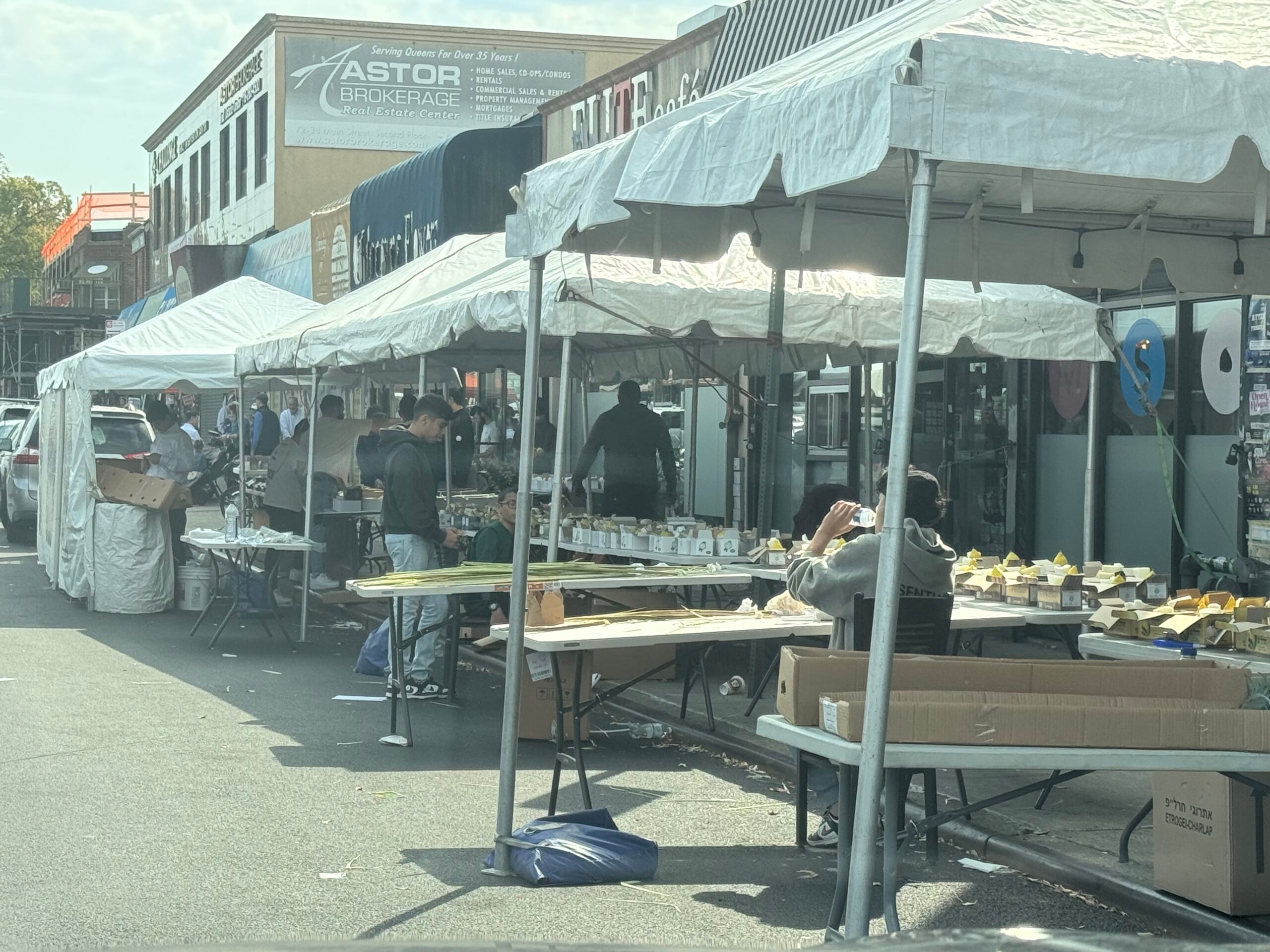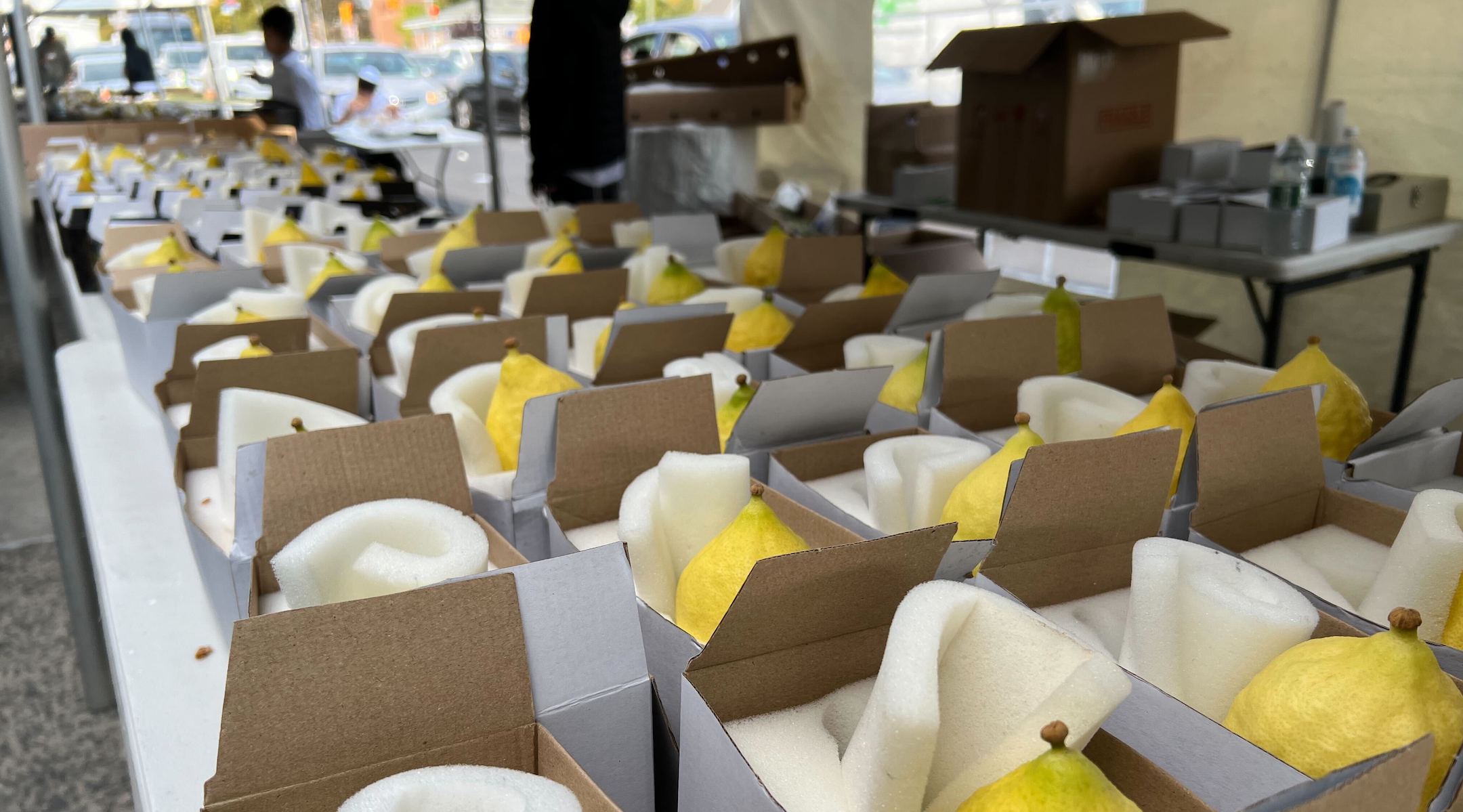My longtime friend Toby and I have a cherished post-Yom Kippur tradition: Every year we hop in my car and head to Kew Gardens Hills — the Queens neighborhood not too far from where I grew up in Forest Hills — to do some extremely seasonal shopping on Main Street.
No, we’re not getting ready for Halloween, nor are we stocking up ahead of Thanksgiving. Instead, we’re heading to one of the most unique, temporary Jewish spaces in the city: a pop-up market that sells etrogs, the citrus fruit that is one of the four species that Jews hold and shake during the weeklong harvest holiday of Sukkot.
Such temporary etrog markets pop up in select Jewish neighborhoods across the city, including in Borough Park and Williamsburg in Brooklyn. While many Jews who purchase etrogs do so through their synagogues, for many New York Jews, selecting an etrog at these pop-ups is a time-honored tradition. Of the four species needed for the holiday — which also includes a lulav (palm) branch, flanked by three myrtle and two willow branches — the etrog is the star of the show, and its perceived value constitutes the cost of the complete set.
On Sunday on Main Street in Kew Gardens, Toby and I drive until we see some long, rectangular tables lining the sidewalk in front of Seasons Kosher Supermarket. The heart of the action is just a few blocks away, between 71st Road and 73rd Avenue. There, tables are covered with small boxes, each containing a single etrog nestled in foam. The fruits on display hail from Israel, Yemen and Morocco, with prices ranging from $25 for small damaged etrogs meant for children’s play to larger specimens that can cost hundreds of dollars, or more.
These etrog stands — on Sunday, there were almost 20 — are typically staffed by yeshiva students, mostly teens but some as young as 11 or 12. The students clearly have their strokes down, singing out to prospective customers: “Do you need an etrog? Come see what I have!” Wandering from table to table, it’s easy to forget for a moment that it’s actually 2024, when anyone can purchase almost anything online (including lulav and etrog sets from Amazon, available for overnight delivery). Instead, we’re transported back to a simpler time, almost like we’re visiting a bazaar in an Old World shtetl.
Toby and I proceed from one seller to the next in search of the best deal. Toby is my “Brooklyn muscle” — she won’t hesitate to bargain with merchants of any age or size. I find myself gravitating towards the etrogs in the $60 to $75 range; they’re plumper and smoother than the least expensive offerings. It doesn’t take long before the eager young sellers ask me my price range to move the sale along.
“We’re all family, we all know each other,” a seller named David Mirzayev, who was working alongside two young nephews, told the New York Jewish Week’s Lily Lester, who also visited the Kew Gardens market.
Although some tables are set up before Yom Kippur, the high season for the etrog hunt is between Yom Kippur and the first night of Sukkot, which this year begins on Wednesday night. During that time, the kids are behind the tables every day except Shabbat, when the market is closed.
“Most — 85% —are off from [school] Yom Kippur through Sukkot,” Daniel Izhakov, a 17-year-old student at the Jewish Institute of Queens tells me, explaining the youth involvement in the market.
Many of the students work on commission. Izhakov, selling for his third year, proudly shares that he earns 15% to 20% of each sale — plus a bonus — while his 14-year-old brother, Yaacov, earns 10%, as he’s only in his second year. Daniel tells me that children as young as 9 or 10 sell etrogs at markets elsewhere in the city.
Hiski Mierov runs Sukkah & Esrog Empire with a partner out of a vacant storefront they rent on Main Street. He tells me that the kids who manage his tables do so for “chesed hours” (community service) and tips.
“The parents drop them off — they have no school; this is better than playing video games,” he said. “I get the kids a table outside, give them 50 etrogs, treat them like a wholesaler and they owe me a certain amount over cost. And they get a free lunch at my restaurant, Holy Schnitzel.”
Meirov claims to be the only seller offering “free pitom insurance,” promising to replace any etrog whose small tip protrusion is broken off before the holiday, rendering it not kosher to perform the mitzvah of waving the etrog in the sukkah.
Much like diamond shoppers look out for “the 4cs” to determine quality, discerning etrog customers have specific characteristics and standards they seek. “Of course the shape, the quality and the smell,” Izhakov said, detailing what shoppers should keep in mind. “If it smells good, looks good, you got a keeper.”
But Izahahkov also spoke of “teami,” meaning “to my taste” — meaning that finding the “perfect” etrog is a personal decision.
“You know if you have a Michelin [restaurant] and you pay a lot, but some just want a $30 steak,” he said.
There is a purity concern for more discriminating customers, who look for certifications of kashrut from rabbis they trust, and require their etrogs to be “Chazon Ish” — a reference to an early 20th-century rabbi who once proclaimed upon spotting a perfect specimen, “This is an etrog.” The term today describes an etrog that is free from suspicion of graft implanting or cross-breeding, which could invalidate them.
“Chazon Ish ones are from Yemen or Morocco — the seeds are not mixed with other citrus,” explains a 16-year-old seller named Jacob.
Jacob shows us a 10-pound, $450 etrog about the size of a football — he calls it “the big one from Yemen.” He explains that the Moroccan ones he sells, many of which are green, “are just raised in a different environment.”
Both countries of origin have experienced complications in the last year. Yemen has been embroiled in the regional war against Israel through the Houthis, an Islamist group based there. And Morocco experienced a devastating earthquake just before the etrog harvest last year, which has had ramifications for this year’s crop.
The consensus at the tables is that green etrogs are acceptable, but I’m skeptical — in all my years, I’ve never seen a synagogue use a green etrog during Sukkot. Jacob tries to allay my fear, telling me, “If it’s green, it will 100% ripen by yontiff,” using the Yiddish word for holiday.

While some of the etrog sellers temporarily rent vacant commercial space, many simply set up tables on the sidewalk. (Risa Doherty)
As I looked down the tables at the hundreds of etrogs on offer, I couldn’t help but wonder what happens to the unsold ones. Jacob says that about 10% go back to the original seller, and the rest are thrown out. Mierov, however, sells the leftovers for a dollar each to those who want to make etrog jam or tea.
“The best thing after [the holiday] is my mom’s jam,” a 12-year-old seller named Jonathan tells me. “My mom’s is the best.”
Toby and I had been wandering among the tables for about 20 minutes, and I was still wavering in my decision. I had considered a decent prospect at one table, but it was too bumpy for my taste. Another one had caught my eye but it wasn’t fragrant enough. Our search finally ends when Toby motions me toward a table featuring a four-inch, radiant yellow etrog that felt smooth on top. She gently rubs the rind to release its citrusy aroma and passes it to me.
“This is the one!” I exclaim, delighting in how it fits perfectly in my hand. “I love it!”
The young seller says this etrog is $45, which Toby and I deem too expensive. The seller quickly counters with $35 — a deal.
He and his partner compile the accompanying pieces, which include a holder and ties made from palm branches, which are placed around the lulav to stop its fronds from flaring out wildly, especially when the owner is shaking it as part of the prayer ritual. The kids invite me to select the lulav of my choice, dropping it into a plastic sleeve. They hand me my selection, which fits snugly in a foam cut-out etrog-shaped space inside its cardboard box.
“Thank you and chag sameach,” the sellers say, wishing a happy holiday to Toby and me. We then make our way down the street back to the car, heads held high. We’re etrog mavens now, and we’re already looking forward to returning next year.
The New York Jewish Week brings you the stories behind the headlines, keeping you connected to Jewish life in New York. Help sustain the reporting you trust by donating today.





